
The University of Glasgow is a public research university in Glasgow, Scotland. Founded by papal bull in 1451, it is the fourth-oldest university in the English-speaking world and one of Scotland's four ancient universities. Along with the universities of Edinburgh, Aberdeen, and St Andrews, the university was part of the Scottish Enlightenment during the 18th century.
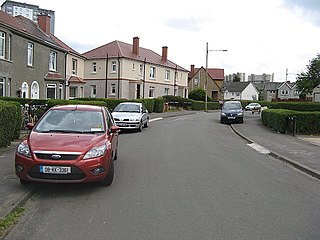
Cardonald is an outlying suburb of the Scottish city of Glasgow. Formerly a village in its own right, it lies to the southwest of the city and is bounded to the south by the White Cart Water. The area was part of Renfrewshire until 1926 when the villages of Cardonald, Crookston, Halfway and their surrounding farmland were annexed to Glasgow.

George Square is the principal civic square in the city of Glasgow, Scotland. It is one of six squares in the city centre, the others being Cathedral Square, St Andrew's Square, St Enoch Square, Royal Exchange Square, and Blythswood Square on Blythswood Hill.

Cathcart is an area of Glasgow between Battlefield, Mount Florida, King's Park, Muirend and Newlands. The White Cart Water flows through Cathcart, downstream from Linn Park. In 2014, it was rated one of the most attractive postcode areas to live in Scotland.

Glasgow Royal Concert Hall is a major concert and arts venue, in the city of Glasgow, Scotland. It is owned by Glasgow City Council and operated by Glasgow Life, an agency of Glasgow City Council, which also runs Glasgow's City Halls and Old Fruitmarket venue.
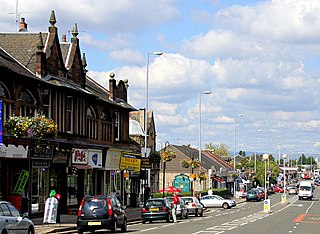
Giffnock is a town and the administrative centre of East Renfrewshire in the Central Lowlands of Scotland.
Catherine Roxburgh Carswell was a Scottish author, biographer and journalist, now known as one of the few women to take part in the Scottish Renaissance. Her biography of the Scottish poet Robert Burns aroused controversy, but two earlier novels of hers, set in Edwardian Glasgow, were little noticed until their republication by the feminist publishing house Virago in 1987. Her work is now seen as integral to Scottish women's writing of the early 20th century.
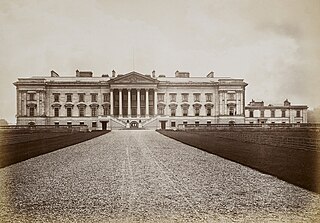
Hamilton Palace was a country house in Hamilton, South Lanarkshire, Scotland. The former seat of the Dukes of Hamilton, it dated from the 14th century and was subsequently much enlarged in the 17th and 19th centuries. Widely acknowledged as having been one of the grandest houses in the British Isles, the palace was situated at the centre of the extensive Low Parks, with the Great Avenue, a north–south tree-lined avenue over three miles in length, as its axis. The Low Parks also contained the Hamilton Mausoleum designed by David Hamilton and the 11th-century Netherton Cross, while the High Parks contain Chatelherault Hunting Lodge designed by William Adam. Hamilton Palace was demolished between 1921 and 1926 after coal works beneath the house were discovered to threaten its structural integrity.
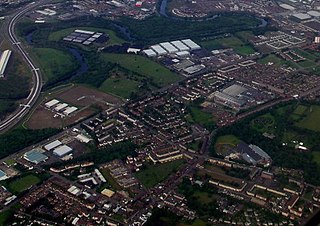
Tollcross is an area north of the River Clyde in Glasgow and has a popular park, opened in 1897, which is famed for its international rose trials. It lies approximately a mile east of the neighbouring suburb of Parkhead, and just north of Braidfauld and south of Shettleston.

James Salmon (1805-1888) was a Scottish architect, active chiefly in Glasgow and the west of Scotland.

Dennistoun is a mostly residential district in Glasgow, Scotland, located north of the River Clyde and in the city's east end, about 1+1⁄4 miles east of the city centre. Since 2017 it has formed the core of a Dennistoun ward under Glasgow City Council, having previously been a component of the East Centre ward.

The Kelvin Hall, located on Argyle Street in Glasgow, Scotland, is one of the largest exhibition centres in Britain and now a mixed-use arts and sports venue that opened as an exhibition venue in 1927. It has also been used as a concert hall, home to the Kelvin Hall International Sports Arena to 2014, and from 1988 to 2010, Glasgow's Museum of Transport. As part of the economic redevelopment of Greater Glasgow promoted by the Scottish Development Agency and local authorities to enhance the city's tourist infrastructure and to attract further national and international conferences, the Scottish Exhibition and Conference Centre was designed as the Hall's successor for exhibitions and entertainments, built and opened on the nearby Queen's Dock in 1985 with an exhibition area equal in size to the Kelvin Hall but with the benefit of extensive car parks and land for other complementary buildings. The Hall is protected as a category B listed building, and is served by city bus services and by Kelvinhall subway station.

Ardmillan is a mainly residential suburb of Edinburgh, Scotland. The area developed during the mid to late Victorian era as Edinburgh expanded and many of the present tenement flats and houses date from this era. The area is bisected by the A70 road and its north-west edge is marked by the Shotts railway line. The area has several pubs, small shops, churches and a cemetery.

His Majesty's Theatre in Aberdeen is the largest theatre in north-east Scotland, seating more than 1,400. The theatre is sited on Rosemount Viaduct, opposite the city's Union Terrace Gardens. It was designed by Frank Matcham and opened in 1906.
The High School of Glasgow is an independent, co-educational day school in Glasgow, Scotland. The original High School of Glasgow was founded as the choir school of Glasgow Cathedral in around 1124, and is the oldest school in Scotland, and the twelfth oldest in the United Kingdom. On its closure as a selective grammar school by Glasgow City Corporation in 1976, it immediately continued as a co-educational independent school as a result of fundraising activity by its Former Pupil Club and via a merge by the Club with Drewsteignton School. The school maintains a relationship with the Cathedral, where it holds an annual service of commemoration and thanksgiving in September. It counts two British Prime Ministers, two Lords President and the founder of the University of Aberdeen among its alumni.

The Park District of the West End of the city of Glasgow, Scotland, is an area located around Park Circus, which sits atop Woodlands Hill, beside Kelvingrove Park.
Aberdeen University Sports Union (AUSU) is the sports union at the University of Aberdeen, Scotland. It is a constituent part of Aberdeen University Students' Association. It is not responsible for facilities and rents time for its clubs from Aberdeen Sports Village.
The Saracen Foundry was the better-known name for the Possilpark, Glasgow–based foundry company W MacFarlane & Co. Ltd, founded and owned by Walter MacFarlane. MacFarlane's was the most important manufacturer of ornamental ironwork in Scotland.
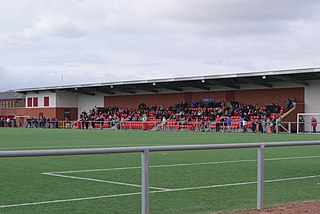
Petershill Park is a leisure centre and football stadium located in the Springburn suburb of Glasgow, the largest city in Scotland. It has a third generation full-size outdoor football pitch, and has floodlights.
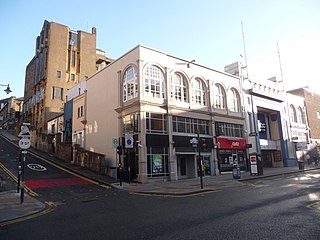
The O2 ABC was a nightclub and music venue on Sauchiehall Street, in the centre of Glasgow, the largest city in Scotland. The building was constructed in 1875, renovated many times in its lifetime and also largely rebuilt in the 1920s. The building has been used for numerous functions before being finally converted to its current purpose between 2002 and 2005. In 2009, the Academy Music Group took a majority stake in the venue, rebranding it the O2 ABC. The venue is protected as a category C(S) listed building. In March 2009; the Academy Music Group became the major stockholder of the O2 ABC.

















